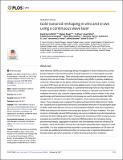Gold nanorod reshaping in vitro and in vivo using a continuous wave laser
Abstract
Gold nanorods (GNRs) are increasingly being investigated for cancer theranostics as they possess features which lend themselves in equal measures as contrast agents and catalysts for photothermal therapy. Their optical absorption spectral peak wavelength is determined by their size and shape. Photothermal therapy using GNRs is typically established using near infrared light as this allows sufficient penetration into the tumour matrix. Continuous wave (CW) lasers are the most commonly applied source of near infrared irradiation on GNRs for tumour photothermal therapy. It is perceived that large tumours may require fractionated or prolonged irradiation. However the true efficacy of repeated or protracted CW irradiation on tumour sites using the original sample of GNRs remains unclear. In this study spectroscopy and transmission electron microscopy are used to demonstrate that GNRs reshape both in vitro and in vivo after CW irradiation, which reduces their absorption efficiency. These changes were sustained throughout and beyond the initial period of irradiation, resulting from a spectral blue-shift and a considerable diminution in the absorption peak of GNRs. Solid subcutaneous tumours in immunodeficient BALB/c mice were subjected to GNRs and analysed with electron microscopy pre- and post-CW laser irradiation. This phenomenon of thermally induced GNR reshaping can occur at relatively low bulk temperatures, well below the bulk melting point of gold. Photoacoustic monitoring of GNR reshaping is also evaluated as a potential clinical aid to determine GNR absorption and reshaping during photothermal therapy. Aggregation of particles was coincidentally observed following CW irradiation, which would further diminish the subsequent optical absorption capacity of irradiated GNRs. It is thus established that sequential or prolonged applications of CW laser will not confer any additional photothermal effect on tumours due to significant attenuations in the peak optical absorption properties of GNRs following primary laser irradiation.
Citation
Harris-Birtill , D , Singh , M , Zhou , Y , Ruenraroengsak , P , Gallina , M E , Hanna , G B , Cass , A E G , Porter , A E , Bamber , J & Elson , D S 2017 , ' Gold nanorod reshaping in vitro and in vivo using a continuous wave laser ' , PLoS ONE , vol. 12 , no. 10 , e0185990 . https://doi.org/10.1371/journal.pone.0185990
Publication
PLoS ONE
Status
Peer reviewed
ISSN
1932-6203Type
Journal article
Description
Funding for this project was provided by ERC grant 242991 (D. Elson), and by Cancer Research UK via the CRUK Cancer Imaging Centre at the Institute of Cancer Research (ICR) to J. Bamber. We acknowledge an ERC starting grant (project number 257182) to A. Porter, and BRC funding (project number P46143) to A. Porter, D. Elson and P. Ruenraroengsak. We acknowledge NHS funding to the NIHR Biomedical Research Centre at The Royal Marsden (J. Bamber) and at Imperial College London, as well as support provided by the Cancer Research UK Imperial Centre.Collections
Items in the St Andrews Research Repository are protected by copyright, with all rights reserved, unless otherwise indicated.

